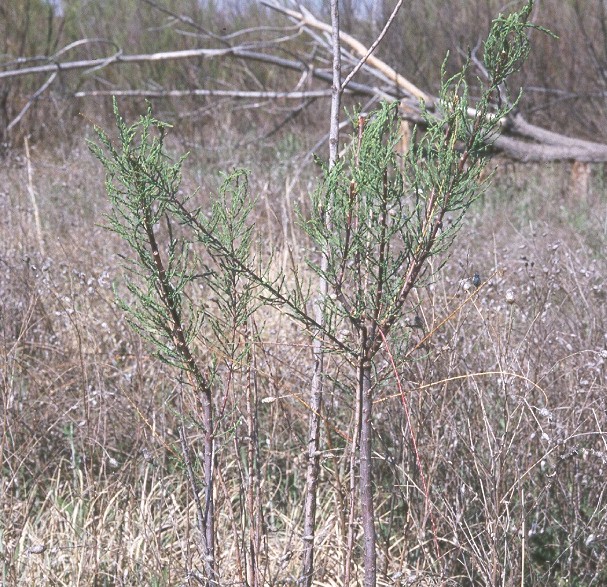- Tamarix ramosissima--salt
cedar
Tamaricaceae
Weed ID Link Plant Flower
 Photo
by Ron Lang, USDA-APHIS-PPQ. Location: WY.
Photo
by Ron Lang, USDA-APHIS-PPQ. Location: WY.
Family: Tamarisk (Tamaricaceae)
Flowering: March-April
Field Marks: The 5 sepals ( One of the outermost circles of modified leaves surrounding the reproductive organs) of this species are toothed, distinguishing this tamarisk from all others.
Habitat: Moist areas in the desert.
Habit: Shrub or small tree to 20 feet tall; bark reddish brown.
Stems: Erect, spreading, smooth.
Leaves: Alternate, scale-like, lanceolate- (Shaped like a lance-head, several times longer than wide, broadest above the base and narrowed to the apex), blue-green, sessile, up to 1/6 inch long, smooth.
Flowers: Many borne in racemes- (A simple inflorescence of pediceled flowers upon a common more or less elongated axis) that are arranged in open panicles, each raceme up to 2 inches long, each flower on a very short stalk; bracts about as long as or longer than the flower stalks.
Sepals: 5, green, free from each other, up to 1/16 inch long, toothed along the edges.
Petals: 5, pink, free from each other, obovate, 1/12-1/8 inch long.
Stamens: 5, attached beneath a disk in the flower.
Pistils: Ovary superior; styles 3.
Fruits: Capsule narrowed into a beak, longer than the petals, with tuft of soft bristles at the tip.
General Distribution:
Saltcedar is an introduced species native to Asia
and Southeastern Europe. Since its escape from cultivation in the
1870's, saltcedar has become extensively naturalized in the southwestern
United States and Mexico. It extends north to Massachusetts, Indiana,
Missouri, Kansas, Colorado, Nebraska, and Oklahoma. Small but
well-established stands of saltcedar occur in Oregon, Idaho, Montana,
Wyoming, and South Dakota.
Management Considerations:
Saltcedar has become a serious weed species in the
Southwest during the past half-century. In some disturbed areas,
native riparian vegetation has been completely replaced by pure stands
of saltcedar.
Flooding Damage: Dense stands of saltcedar have caused flood damage by impeding flow at high water stages.
Water Loss: Saltcedar has a very high leaf area index and can dry up wetlands, lower water tables, and reduce water yield of riparian areas. Use of groundwater is greatest where the height and density of saltcedar are at a maximum, the water table is shallow, and the climate is hot and dry. The rate of water use by saltcedar under favorable conditions is more than 9 acre-feet/acre/year (11,101 m cubed/ 0.4 ha/year) in Arizona. Along the Colorado River it has been estimated that up to 568,000 acre feet of water are lost per year to channel vegetation, with saltcedar being a major component.
Restructuring River Channels: Saltcedar's dense roots and rhizomes spread out and slow river flow, which increases deposition. When this occurs a number of times at high water, sediments build along the riverbank. As the river recedes, saltcedar colonizes farther out into the flood plain, widening the riparian zone. This process can severely reduce stream flow or rechannel it.
Control/Herbicides: Saltcedar is difficult or impossible to kill by burning, drought, freezing, prolonged submersion, or repeated cutting at ground level. However, saltcedar can be controlled using a combination of methods.
Some herbicides used for saltcedar control are 2,4-D, Dicamba, Tordon, Triclopyr ester, and Arsenal. The herbicide Silvex has been used successfully to control saltcedar, but several restrictions have been placed on its use. The U.S. Department of Interior has totally prohibited its use on Interior lands.
For control using cut-stump/herbicide treatments the following steps should be followed: Cuts should be made within 2 inches (5 cm) of the ground surface; the herbicide should be applied to cut stumps within a few minutes after cutting; the entire circumference of the cambium layer should be cut and treated; sprouting foliage should be cut and treated within a year after the initial treatment.
Biological control: In its native range,
115 insect species and four mites are known to attack saltcedar.
A few may be candidates for biological control.
By: RK. 1/2001.
Sources:
1.http://tncweeds.ucdavis.edu/esadocs/tamaramo.html
Alan T. Carpenter, Land Stewardship Consulting, 2941 - 20th Street, Boulder, CO 80304 (303/443-8094)
2. http://hoya.mobot.org/gradstudents/gaskin/johnpage.html home page of John Gaskin
3. http://tncweeds.ucdavis.edu/esadocs/tamaramo.html The Nature Conservancy
4. http://ag.arizona.edu/classes/ram382/plntpix/tara.html Ag. Arizona
5. http://www.fs.fed.us/database/feis/plants/shrub/tamram/ Fire Effects Information System
6. http://www.catalinaconservancy.org/er/plants/tamaramo.htm The Nature Conservancy
7. http://sevilleta.unm.edu/~cleverly/tam.html James Cleverly
8. http://www.npwrc.usgs.gov/resource/othrdata/westflor/species/5/tamaramo.htm Western Wetland Flora
Back mtwow.org HOME